What is Cave Conservation?
Caves may seem impervious to the influence of man. Like mountains, they have been around for hundreds of thousands, even millions, of years. Aside from naturally occurring events, such as earthquakes and floods, any particular cave will remain unchanged. But caves and the formations they contain are sensitive. Unlike trees on a mountain, formations and even caves themselves are a non-renewable resource which can be easily damaged by man. The tiniest soda straws, which can be broken in one careless move, can take decades, or even eons to replace. In much of the Western Region, caves are “dead,” meaning that once a formation is broken, it will not form again. For these reasons, it is important to follow a “leave no trace” ethic when visiting a cave.
But concern for the wellbeing of caves is not limited to limestone (or marble) and calcite formations. Caves and the land that contains them are incontrovertibly tied together. What happens on the surface can affect the subsurface, including groundwater and caves. Activities on the land’s surface – including pollution, construction, dumping, quarrying, and runoff from agricultural chemicals can adversely affect the quality of groundwater, damaging unique species in and around caves.
What can be done?
What steps can we, as cavers, do to ensure that caves are preserved for all times? We can attempt to prevent damage from happening to caves. We can educated the ourselves and the community around us about the special nature of caves. We can “cave softly” taking care in our own actions, caving appropriately and encouraging others to do so. The most sure-fire way to protect a cave is to not publicize its location. We can also take steps which undo, or attempt to undo damage that has already occurred. We can gate caves that are particularly at risk. We can engage in restoration projects, to attempt to restore damage that has been done. We can help “Save the Caves” by supporting cave conservancies and preserves
Education
We can educate ourselves and community members as to the special nature of caves. The more the general public is aware of caves, the more likely we are to garner support in stopping vandalism, decreasing dumping and pollution, and passing legislation to protect caves.
Here are some photos from the 1994 Regional which show a crude obstacle course constructed by Martin Haye and Dan Snyder of the Diablo Grotto. This is a good example of cavers educating themselves on the importance of learning to move carefully in a cave.
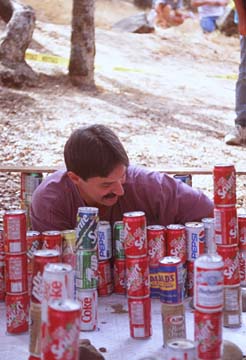
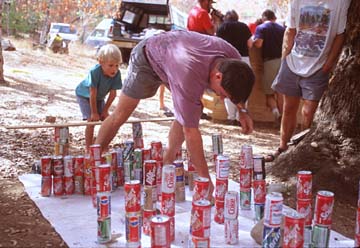
Cave softly
[the following is adapted from “A Short Note on Cave Conservation” by Rob Tayloe]
When underground, please try to keep the following in mind:
1. When in a cave passage—particularly an entrance or stream passage—keep in mind that there may be critters (salamanders and many others) that may be difficult to see, but nevertheless need us to steer clear of them. For this reason, try to go as slowly as possible through entryways or water passages, looking for tracks and the individuals themselves. When such a critter is encountered try best to warn others in your group of its location, and if necessary, place the critter in a safer area so it won’t get trampled.
2. When walking through a passage, try best to keep muddy hands (and even non-muddy ones) from touching the walls and formations. Please try best to place hands for momentum and balance in a location where the mud that gets left behind is seen as little as possible. It may not seem like much, but your mud, and the mud of others does add up. It is quite amazing that just a little mud can really ruin what was once a very white formation.
3. Likewise, keep in mind where your body is in relation to the rest of the cave. In other words, try to keep your body as far away as possible from soda straws, bacon, etc. that may be just dangling above you. Your head is protected by a helmet, but there is nothing to protect the formations except for you!
4. Take all the stuff that you brought into the cave back out with you. This means making sure that all those little things, like food, candy wrappers, batteries, film, etc. are packaged properly and can’t get lost as you travel along the cave. Besides being unsightly, these items are toxic to the cave critters and can leach into the soil.
5. If you encounter bats, keep your conversation to a low, but do NOT whisper. Also, refrain from shining lights on them—would you like to be disturbed when sleeping by a bright light? If a bat is flying around the same passage as you, don’t panic, just stay as close to the walls and floor as you can until they leave. A bat, when it is in an area its familiar with, will not always use its sonar to detect obstacles.
6. Remember that the cave you are visiting is the home to the critters that live there. There is a very delicate balance involved in a cave system, it does not take much to screw it up. Be aware that your actions could disrupt the habitat of these creatures, and could possibly kill them.
7. Do whatever you can to leave the cave as you found it, if not better. So that the next person (who may be yourself) that visits the cave can enjoy the cave as much as you did. This includes keeping an eye out for other’s trash, spent batteries, etc. and taking it out with you.
Not disclosing locations
Sometimes the best way to protect caves is through silence.
Gating caves
Some caves are at high risk for damage because of their location (close to a road, well known by local youth, etc.); other caves, because of their vertical nature, are a hazard to inexperienced visitors; other caves contain fragile formations or rare species which need to be protected. All of these may be reasons for restricting access to caves. Sometimes the only sure way to ensure that appropriate access is maintained is to gate the cave and control the key. Cavers can assist with this by following established procedures for checking out and returning keys, by monitoring gates and reporting any attempted break-ins, by ensuring that party members all meet the set requirements for accessing the cave.
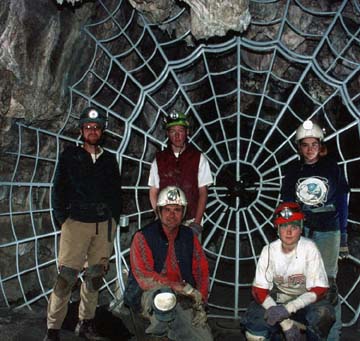
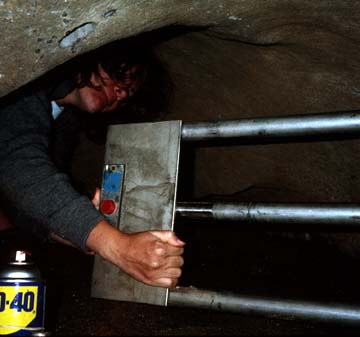
Restoration
We can engage in cleanup projects as volunteers, and encourage new cavers to participate in such activities. Helping on restoration or cleanup projects is a good way for new cavers to learn what not to do. Such projects can range from cleaning mud-smeared formations, to cleaning graffiti, to hauling out trash and batteries, to picking lint off of formations or clearing blast rubble in a commercial cave.
Here are some photos of restoration work underway at Lilburn Cave:
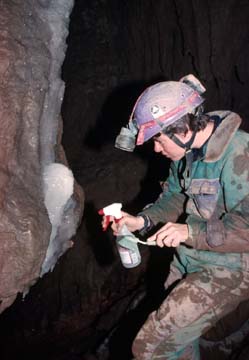
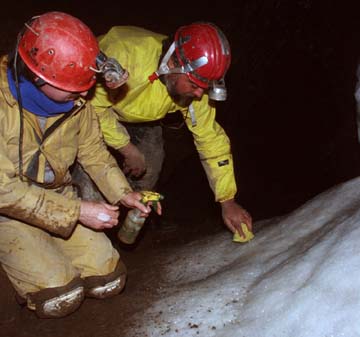
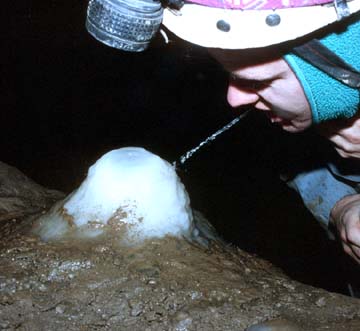
The NSS Policy for Cave Conservation:
[the following is taken from the NSS Web pages on Cave Conservation]
The National Speleological Society believes: That caves have unique scientific, recreational, and scenic values; That these values are endangered by both carelessness and intentional vandalism; That these values, once gone, cannot be recovered; and That the responsibility for protecting caves must be assumed by those who study and enjoy them.
Accordingly, the intention of the Society is to work for the preservation of caves with a realistic policy supported by effective programs for: the encouragement of self-discipline among cavers; education and research concerning the causes and prevention of cave damage; and special projects, including cooperation with other groups similarly dedicated to the conservation of natural areas. Specifically:
All contents of a cave – formation, life, and loose deposits – are significant for its enjoyment and interpretation. Therefore, caving parties should leave a cave as they find it. They should provide means for the removal of waste; limit marking to a few, small and removable signs as are needed for surveys; and, especially, exercise extreme care not to accidentally break or soil formations, disturb life forms, or unnecessarily increase the number of disfiguring paths through an area.
Scientific collection is professional, selective, and minimal. The collecting of mineral or biological material for display purposes, including previously broken or dead speleothems, is never justified, as it encourages others to collect and destroys the interest of the cave.
The Society encourages projects such as: establishing cave preserves; opposing the sale of speleothems; supporting effective protective measures; cleaning and restoring over-used caves; cooperating with private cave owners by providing knowledge about their cave and assisting them in protecting their cave and property from damage during cave visits, and encouraging commercial cave owners to make use of their opportunities to aid the public in understanding caves and the importance of their conservation.
Where there is reason to believe that publication of cave locations will lead to vandalism before adequate protection can be established, the Society will oppose such publication.
It is the duty of every Society member to take personal responsibility for spreading a consciousness of the cave conservation problem to each potential user of the caves. Without this, the beauty and value of our caves will not long remain with us.
